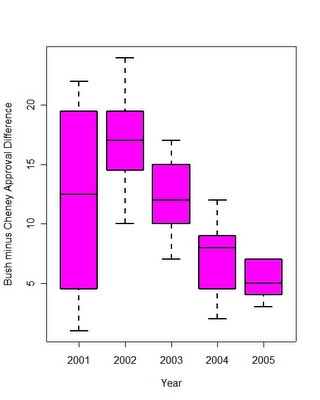
Vice-President Cheney's approval ratings, while consistently lower than those of President Bush, have converged with those of the President, especially in the last year. The two ratings are very highly correlated (above .90) but the Vice-President's approval generally trailed that of the President by double digits in the first three years of the Bush-Cheney administration. The gap narrowed to under 10 points in 2004 and narrowed again to about 5 points in 2005.

(Note on the figure: The rectangles represents the 25th-75th percentiles of all polls in each year. The horizontal line inside the rectangle is the median of annual polls. The dashed line extends to indicate the extreme values in each year.)
The 2004 campaign and subsequent second inaugural appear to have marked the convergence of the two approval ratings. Since January 2005 both approval levels have fallen from around 50% to the low-to-mid 30% range. But both have dropped at about the same rate.
Earlier in the administration, the gap between approval ratings was much larger. Whether this is due to the President's extraordinary high standing in the wake of 9/11, the Vice-President's relative obscurity during this time, the common practice of giving Vice-Presidents the more partisan role, or the frequent criticism of the Vice-President in connection with Halliburton is uncertain.
In each of the major events which drove the President's approval rating (9/11, start of Iraq war, capture of Saddam Hussein) the Vice-President's ratings rose, but less so than those of the President. This is exactly what we would expect given the two men's roles.
I suspect the convergence is also due to the collapse of support from Democrats and the substantial fall in approval among Independents. With both Presidential and Vice-Presidential approval now resting primarily with the Republican base, there is less variation in support. When Independents and even a fair number of Democrats approved of the President, there was more room for these groups to provide lower levels of support for Cheney, thus creating a greater gap between Presidential and Vice-Presidential appoval. With Democratic approval now at or below 10% and Independent approval in the low 30% range, Republican identifiers are more likely to approve of both and hence produce the convergence we see.
While some commentators seem to believe that the Vice-President faces much lower approval than the President, the fact is that those days are substantially over. The linked fate of the two is now tighter than ever.
P.S. A reader commented that they would like to see the comparison for Gore and Clinton. Here it is for the modest amount of data available. I could not find Gore job approval prior to 1997. Harris did some polling then, but not enough for a very clear graph, so I also had to switch to Fox, which has a very good series starting in 1998. Fox uses the more common "Approve/Disapprove" question format.

P.P.S. Saddlebags12 and Robert both raise the important question of the don't know rate, which can affect this sort of an issue. In the case of Cheney and Bush, there are some effects, but not enough to reverse my point which is that Cheney is not dramatically less approved of than Bush. The figure below shows three things (responding the the comments):
1) The raw disapproval rate for Cheney was a bit higher than for Bush in the first term, not the other way around. In the second term the disapproval rates are nearly identical.
2) Despite 1, Cheney's don't know rate was considerably higher than Bush's in the first term. This dropped to near-parity during the 2004 campaign. In 2005 the Cheney don't know rate has grown a bit, but is still 1/3 what it was in most of the first term.
3) If we take out the Don't Knows, by recalculating approval based only on the (Approve+Disapprove) denominator, then we find that Cheney was below Bush in approval through the first term, with the gap narrowing considerably during the 2004 campaign and in 2005. Qualitatively this is the same story as I originally told above, though the numerical differences are a bit shifted. (The Disapprove figures are just the complement of the approve when the DKs are removed, so I just show the approve figure.)
4) Different polls might be more sensitive to this. For example, the Fox data I used for the Gore-Clinton comparison has a higher DK rate for Gore than the Harris data do for Cheney-Bush.
5) Don't Knows can bite you. They didn't change my argument here, but they can't be ignored without peril.

Data: The Cheney-Bush data are from Harris Polls. Harris is the only organization to publish a substantial number of both Presidential and Vice-Presidential approval results. By keeping to a single polling organization, we also avoid making comparisons across different question wording and organizational practices that contribute to differences between surveys. The Harris approval question is a four-alternative version, unlike the most commonly used approval questions. Harris' wording is:
"How would you rate the job Vice President Dick Cheney is doing: excellent, pretty good, only fair, or poor?"
Excellent and pretty good are coded as approval, while only fair and poor are coded as disapproval. These differences in wording appear to have modest effects in approval levels compared to those of other wordings and organizations. The data are available at PollingReport.Com here for the Vice-President. Presidential approval is also available at PollingReport.Com here.